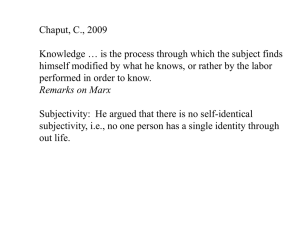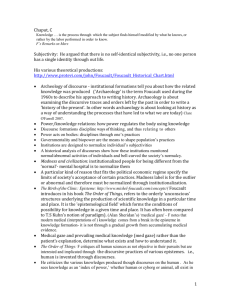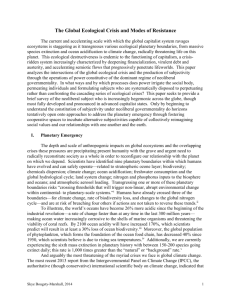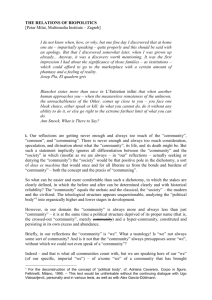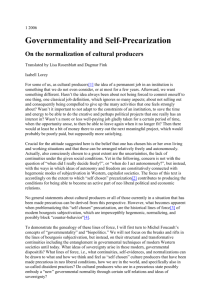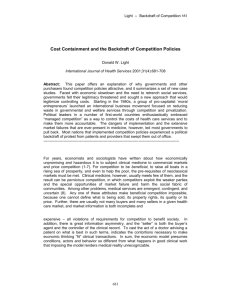Pure, Real and Rational Numbers: The American Imaginary of
advertisement
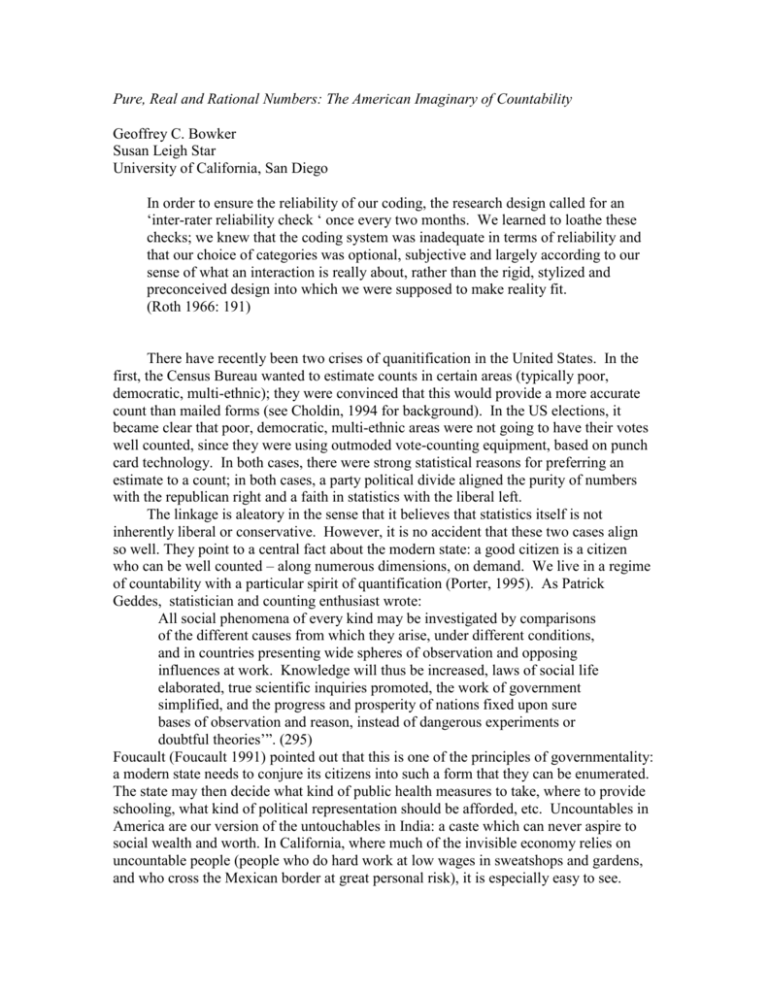
Pure, Real and Rational Numbers: The American Imaginary of Countability Geoffrey C. Bowker Susan Leigh Star University of California, San Diego In order to ensure the reliability of our coding, the research design called for an ‘inter-rater reliability check ‘ once every two months. We learned to loathe these checks; we knew that the coding system was inadequate in terms of reliability and that our choice of categories was optional, subjective and largely according to our sense of what an interaction is really about, rather than the rigid, stylized and preconceived design into which we were supposed to make reality fit. (Roth 1966: 191) There have recently been two crises of quanitification in the United States. In the first, the Census Bureau wanted to estimate counts in certain areas (typically poor, democratic, multi-ethnic); they were convinced that this would provide a more accurate count than mailed forms (see Choldin, 1994 for background). In the US elections, it became clear that poor, democratic, multi-ethnic areas were not going to have their votes well counted, since they were using outmoded vote-counting equipment, based on punch card technology. In both cases, there were strong statistical reasons for preferring an estimate to a count; in both cases, a party political divide aligned the purity of numbers with the republican right and a faith in statistics with the liberal left. The linkage is aleatory in the sense that it believes that statistics itself is not inherently liberal or conservative. However, it is no accident that these two cases align so well. They point to a central fact about the modern state: a good citizen is a citizen who can be well counted – along numerous dimensions, on demand. We live in a regime of countability with a particular spirit of quantification (Porter, 1995). As Patrick Geddes, statistician and counting enthusiast wrote: All social phenomena of every kind may be investigated by comparisons of the different causes from which they arise, under different conditions, and in countries presenting wide spheres of observation and opposing influences at work. Knowledge will thus be increased, laws of social life elaborated, true scientific inquiries promoted, the work of government simplified, and the progress and prosperity of nations fixed upon sure bases of observation and reason, instead of dangerous experiments or doubtful theories’”. (295) Foucault (Foucault 1991) pointed out that this is one of the principles of governmentality: a modern state needs to conjure its citizens into such a form that they can be enumerated. The state may then decide what kind of public health measures to take, where to provide schooling, what kind of political representation should be afforded, etc. Uncountables in America are our version of the untouchables in India: a caste which can never aspire to social wealth and worth. In California, where much of the invisible economy relies on uncountable people (people who do hard work at low wages in sweatshops and gardens, and who cross the Mexican border at great personal risk), it is especially easy to see. And uncountables don’t get heath services, they are not supposed to get an education or buy a car, among other things. There is a “border check” more than fifty miles north up the major highway from Tijuana (San Diego itself is about 15 miles from the border), that examines cars for “illegal aliens.” Whites rarely get stopped, even though the practice of racial profiling has in principle ceased. It should be no surprise that the people who can’t be counted are the people who don’t count. In order to be fully countable, a person needs first to fit into well-defined classification systems. A person without a clearly marked place and time of birth, gender or ethnic category doesn’t just have difficulty getting the papers that they need, the lack of papers can be life-threatening. The state works by counting, and people come to insist on it as a deep form of social legitimacy. As historian Alice Draper has argued, the gendering of Western cultures makes it impossible to be born and remain hermaphroditic (Draper, 1999). One’s parents must choose and thus make the child countably male or female. In the poor areas in Florida there was putatively not enough money to revamp the system by introducing touch-screen voting – this could have cost millions of dollars. The people whose votes weren’t counted were also the people less likely to be counted in the census. There is a convergence (a process of fitting) here between creating a full citizen – which involves situating people into multiple well defined classification systems – and creating a civic apparatus that can serve those people. With both the crisis in the census and in the elections, we see the problems that arise when people are uncountable. Elsewhere, we have documented this phenomenon in patients, nurses, diseases, and in racial categories under apartheid (Bowker and Star, 1999). An additional layer is added in by the fact that the vote itself was so close nationally that the Florida poor made a difference because the political parties themselves targeted the well-defined classes of citizens out there (the Italians; the Jews; the dot com millionaires; the elderly, etc) with such precision and accuracy that they split down the middle. The only people who could make a difference in the election were the ‘others’ – those who didn’t fit into the well defined categories of the state. So this particular quantification crisis was itself brought on by the very success of a quantification effort that has allowed the political parties to shape their polices into the form which the state has shaped us. The current imaginary of most Americans is that everything is, in principle, countable. The “god trick” (Haraway, 1990) enforcing the imaginary occurs when the work of counting is deleted, the decentralization and constant changing of information is deleted, and the technology is black-boxed. This is an old theme in science and technology studies, is it not (see e.g. Star and Strauss, 1999)? The politics of exclusion in both the census case and the election case are not new: Black men were excluded from voting for decades and women of all races until the 20th century. What is interesting for STS is the central role that the media allocated to technology, without challenging the imaginary of total countability. The oportunity afforded to us now is to challenge both the regime of technological counting, and the imaginary of unlimited countability. References: Bowker, Geoffrey and Susan Leigh Star. 1999. Sorting Things Out: Classification and Its Consequences. Cambridge, MA: MIT Press. Choldin, Harvey M.. 1994. Looking for the Last Percent : The Controversy Over Census Undercounts. New Brunswick : Rutgers University Press. Drager, Alice, ed. 1999. Intersex in the Age of Ethics. Hagerstown,MD. : University Pub. Group. Foucault, Michel. 1991. “Governmentality.” in The Foucault Effect: Studies in Governmentality, edited by Graham Burchill, Colin Gordon and Peter Miller. Chicago: University of Chicago Press. P. Geddes, ‘On the Classification of Statistics and its Results. By Patrick Geddes, F.R.S.E., Lecturer on Zoology in the School of Medicine, Edinburgh, and demonstrator of Botany in the University’, in Proceedings of the Royal Society of Edinburgh, 11, 18801882, 295-322 Haraway, Donna. 1990. Simians, Cyborgs, and Women : TheRe-invention of Nature. London : Free Association. Porter, Theodore M., 1995. Trust in numbers : the pursuit of objectivity in science and public life. Princeton, N.J. : Princeton University Press. Roth, Julius A. 1966. “Hired Hand Research.” American Sociologist. 1: 190-196. Star, Susan Leigh and Anselm Strauss. 1999. “Layers of Silence, Arenas of Voice: The Ecology of Visible and Invisible Work”, Computer-Supported Cooperative Work: The Journal of Collaborative Computing, 8: 9-30.
